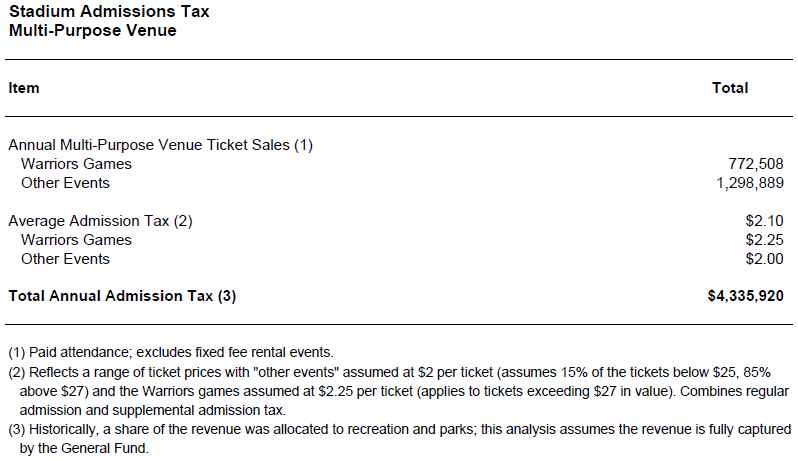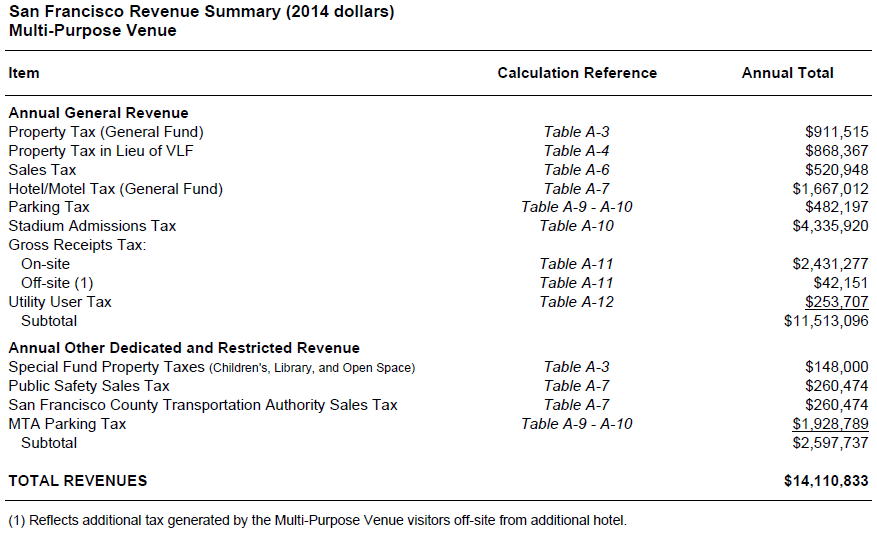With a projected 205 events a year and the forecast attendance per event ranging from 17,000 for a Warriors regular season game to 3,000 when the arena is configured as a “theater,” the proposed Mission Bay Arena for the Golden State Warriors would draw an estimated 2,071,400 ticketed visitors a year and generate $4.3 million in admissions tax revenue for the City of San Francisco.
And including property taxes, sales taxes, parking taxes and a number of other taxes, the arena development would generate roughly $14.1 million in annual revenue for the City, plus one-time taxes and fees of roughly $26.9 million, according to the draft Fiscal Impact Analysis for the development which was delivered to the City yesterday.



That would be $14M more in taxes than UCSF pays for the property in Mission Bay.
+14M
So, what is that you say, UCSF? Can’t hear (not because of noise, but because the shallowness of your pockets.) Follow the lead your own Dr. Cynthia Kim, the pediatric oncologist, who wants to make health care accessible by use of medical visits via tablets (Telehealth.) No more making several hour trips, battling local traffic, parking, stress, of a medical visit when you could “see” your doctor via an ipad.
And your kids breaks their arm? You going to tell them to look at the Ipad?
Telehealth may have its place – but real people sometimes need real hospitals.
You won’t be taking them to this facility as it is not a trauma unit.
Indeed…and no doubt UCSF is behind the “special interest” group of “anonymous UCSF donors” trying to stop the Warriors so that UCSF can take this land for future growth.
If that is the case, then call UCSF’s bluff by revamping the design to include a few more tall housing structures deliberately blocking UCSF’s desired views. Make the housing low-income/elderly, residents on Medicaid/Medicare. Hospitals cannot survive on Medicaid and Medicare alone (see the closure of Doctor’s Hospital in San Pablo, CA.)
And UCSF will try to save your life if you have cancer. The Warriors will entertain you for a few hours. Hmmmm.
In the unlikely event that every penny of that were to go to transit improvements to mitigate the direct impacts of the Stadium we would have something to think about.
In that unlikely event, after 10 years we’d have $141 million – which at Centray Subway construction rates, would get us about 1/7th of a mile of a subway tunnel.
Would be interesting to see an estimate of the taxpayer costs for the additional MUNI service, SFPD, and parking control officers per event planned by Warriors and SF. The Giants got some tax breaks when they build at China Basin that have been worth millions per year.
Speaking of transit improvements, it would be amazing if BART considered placement of its second TB tube close to the arena as BART expansion makes its way north through the SOMA and west toward the Richmond. Then again, we’re talking 2035 at the earliest. Meanwhile, enjoy the snarled traffic and MUNI backups.
To argue the negligible impact of tax breaks to the giants for a few added security, parking and muni resources vs the cultural and fiscal impact that baseball stadium has had on China basin is like questioning the cost of a lottery ticket to win the lottery. Seriously people – we live in a world-class city. Build the God damn thing already.
yes
World-class city with third world transit and crumbling infrastructure. But, a fancy new arena will make us shine even brighter than we are today.
BTW-cynicism aside, I am pro-arena and pro-transit.
If it was just “a few added security, parking and muni resources” then I would agree with you, but of course the Giants wrangled far more than that from SF before they agreed to build their ballpark. For example, the Giants don’t pay the full Stadium Admission Tax, which would be about $2.25/ticket. They only pay $0.25/ticket. That alone has saved them $100 million in taxes. The Giants had many additional ‘special’ deals that add up (namelink from 2005):
“To see why, let’s take a closer look at the Giants’ Pac Bell Park (now SBC Park, and soon to be AT&T Park if the latest merger-related rumors are true). The widely reported $15 million in public funds–used to relocate a public transit facility that was in the way of the ballpark–was just the tip of the iceberg, it turns out. Long estimates $33 million in value for the land itself, donated by the local government for the cause at no cost to the Giants; $25 million worth of municipal fire, police, and garbage services; and $83 million in forgone property taxes, because despite being privatedly owned, the stadium nonetheless receives a full property tax exemption.”
So are you saying that SF gave away too much to the Giants? There weren’t other suitors clamoring for the space to get a bidding war. It was SF’s only credible offer on the table.
Doesn’t matter much now whether SF could have gotten better terms with the Giants or a better use for 12.5 acres of port land on the Embarcadero than to lease it for only $1.2M/year and collect no property taxes on what was built there. Willie Brown and Larry Baer successfully hid the taxpayer subsidy of the operating costs under the veneer of private funding of the capital costs. Sometimes no deal is better than a bad deal, though most/many SF people are happy with this deal because…baseball. I’m sure the port would have had many other suitors for that land willing to pay much more in time. Anyway, that deal is sealed for the next 50 years.
The first Giants proposal for what became Pacbell/SBC/ATT Park included an event/concert space for something like 8-10k. Pressure from locals/NIMBYs helped eliminate that, else there could be something like 200 events/year at China Basin now and the Warriors wouldn’t have nearly the revenue potential they claim they need to make MB work.
A question for the Warriors deal is what will be buried in the fine print or be introduced late in the process. I have always expected they will ask for a similar reduction in the Admission Tax as the Giants and that they will ask for it as a late concession. At least this doesn’t have all the real-estate angles of the previous location to hide the grift. As I wrote on SS over a year ago:
Where the Warriors choose to build may depend as much on the architecture of the deal as the architecture of the building, just like the Giants and 49ers before them.
fiscal benefit to city from building a stadium worth gridlock? zero.
impact on the city from incessant planning appeals and rampant NIMBYism? negative.
cultural benefit to the city= immeasurable.
I believe these are called arenas not stadiums.
Those opposing this on grounds of crowded transit might spend some time in other cities around the country and the world. Subways in big cities get crowded. And on games days, they get even more crowded. Welcome to big cities. Its not the suburbs. Or as every Bostonian/New Yorker/Chicagoan would tell you – Grow a pair and deal with it.
or accept that folks don’t live in those cities because of said conditions.
We are already co-existing with folks who lack aforementioned pair.
$14 million a year is chump change compared to the cost of transit improvements that will be needed.
The City is spending $1+ billion right now for the T-third extension. It spent $750 mil for the original section of T-Third. The Warriors are pretty much building no parking – they need to pony up more for transit improvements.